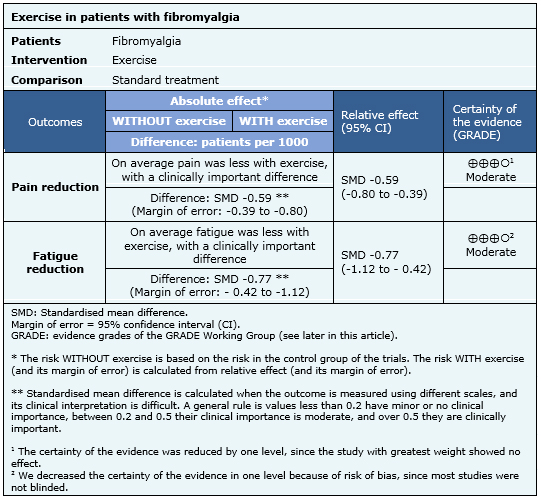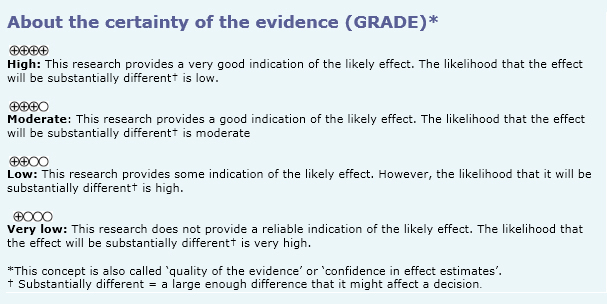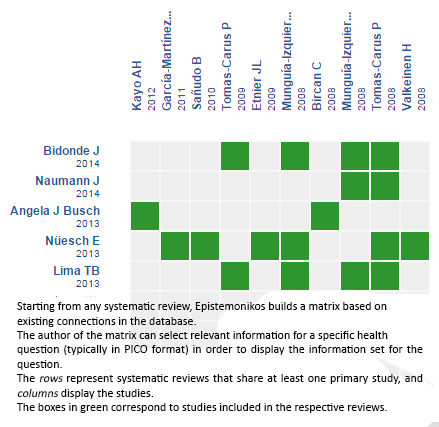Resúmenes Epistemonikos
← vista completaPublicado el 15 de diciembre de 2015 | http://doi.org/10.5867/medwave.2015.6335
¿Mejora el ejercicio los síntomas de la fibromialgia?
Does exercise improve symptoms in fibromyalgia?
Abstract
It has been proposed that fibromyalgia could be managed by pharmacological and non-pharmacological interventions. Regular physical exercise is commonly used as a non-pharmacological intervention. Searching in Epistemonikos database, which is maintained by screening 30 databases, we identified 14 systematic reviews including 25 randomized trials. We combined the evidence using meta-analysis and generated a summary of findings table following the GRADE approach. We conclude that regular physical exercise probably reduces pain in patients with fibromyalgia.
Problem
Fibromyalgia can be a highly incapacitating disease. In its pathophysiology, the presence of inadequate central sensitization and discordant muscle stimulation is proposed. Regular exercise, in addition to its many benefits at a general level, through muscular microstimulus would also allow a better muscular reeducation. However, there is controversy about whether these pathophysiological effects generate improvement in symptoms such as pain and fatigue.
Methods
We used Epistemonikos database, which is maintained by screening more than 30 databases, to identify systematic reviews and their included primary studies. With this information we generated a structured summary using a pre-established format, which includes key messages, a summary of the body of evidence (presented as an evidence matrix in Epistemonikos), meta-analysis of the total of studies, a summary of findings table following the GRADE approach and a table of other considerations for decision-making.
|
Key messages
|
About the body of evidence for this question
|
What is the evidence. |
We found 14 systematic reviews [1],[2],[3],[4],[5],[6],[7],[8],[9],[10],[11],[12],[13],[14], which included 25 randomized controlled trials, reported in 32 references [15],[16],[17],[18],[19],[20],[21],[22],[23],[24],[25],[26], |
|
What types of patients were included |
The studies included patients diagnosed with fibromyalgia, according to the criteria of the American College of Rheumatology, with average ages between 38 and 60 years. Most patients were women. |
|
What types of interventions were included |
Eight studies included only aerobic exercise [16],[17],[25],[27],[28],[30],[31],[38],[41],[43],[46], three studies only included resistance exercise [21],[34],[35] and the remaining 14 studies included a combination of both forms of exercise. Exercise frequency was at least two times a week, with sessions lasting between 20 and 60 minutes. Most of the studies took place in sports facilities and under supervision [16],[19],[21],[22],[23],[24],[26],[28], Interventions that combine mental and physical components as yoga, tai chi and qigong were excluded from this summary. All studies were compared against standard treatment or against a group that did not exercise. |
|
What types of outcomes |
Pain, fatigue, quality of life, sleep, cardiorespiratory function, muscle strengthening, flexibility, depressive and anxious symptoms, self-efficacy. |
Summary of findings
Information about the effects of exercise in patients with fibromyalgia is based on 25 randomized trials that included 1350 patients. Only nine studies reported changes in pain measures [16],[18],[23],[24],[29],[31],[35],[37],[39],[41],[43],[44],[45],[46] and four studies reported variation in fatigue [19],[23],[24],[35],[37],[41],[43],[44],[45],[46].


Other considerations for decision-making
|
To whom this evidence does and does not apply |
|
| About the outcomes included in this summary |
|
| Balance between benefits and risks, and certainty of the evidence |
|
| Resource considerations |
|
|
Differences between this summary and other sources |
|
| Could this evidence change in the future? |
How we conducted this summary
Using automated and collaborative means, we compiled all the relevant evidence for the question of interest and we present it as a matrix of evidence.

Follow the link to access the interactive version: Exercise for fibromyalgia
Notes
The upper portion of the matrix of evidence will display a warning of “new evidence” if new systematic reviews are published after the publication of this summary. Even though the project considers the periodical update of these summaries, users are invited to comment in Medwave or to contact the authors through email if they find new evidence and the summary should be updated earlier. After creating an account in Epistemonikos, users will be able to save the matrixes and to receive automated notifications any time new evidence potentially relevant for the question appears.
The details about the methods used to produce these summaries are described here http://dx.doi.org/10.5867/medwave.2014.06.5997.
Epistemonikos foundation is a non-for-profit organization aiming to bring information closer to health decision-makers with technology. Its main development is Epistemonikos database (www.epistemonikos.org).
These summaries follow a rigorous process of internal peer review.
Conflicts of interest
The authors do not have relevant interests to declare.

